Research on Boundary Displacement of Probe Trajectory Considering Deviations in Five-Axis Sweep Scanning Measurement
Abstract
1. Introduction
2. Constrained Sector of the Probe Tip Trajectory Based on Sampling Principle in Five-Axis Sweep Scanning
2.1. Sampling Principle of Five-Axis Sweep Scanning Measurement
2.1.1. Acquisition of Sampling Points
2.1.2. Driving Method of the Stylus
2.2. Definition of Constrained Sector
3. Constrained Sector Effect on Probe Tip Trajectory Considering Deviations
4. Sweep Scanning Boundary Displacement Based on the Constrained Sector Effect
4.1. Boundary Displacement in a Single Patch
4.2. Boundary Displacement in Multiple Patches
5. Experiments
5.1. Five-Axis Sweep Scanning Measurement Experiments on a Standard Sphere
5.2. Five-Axis Sweep Scanning Measurement Experiments on a Blade
6. Conclusions
Author Contributions
Funding
Data Availability Statement
Conflicts of Interest
References
- Hao, J.C.; Li, Z.Y.; Li, X.Y.; Xie, F.B.; He, D.; Tang, K. Partition-based 3+2-axis tool path generation for freeform surface machining using a non-spherical tool. J. Comput. Des. Eng. 2022, 9, 1585–1601. [Google Scholar] [CrossRef]
- Dong, J.S.; Chang, Z.Y.; Chen, P.; He, J.M.; Wan, N. Tool orientation optimization method based on the best curvature matching. Int. J. Adv. Manuf. Technol. 2023, 124, 127–142. [Google Scholar] [CrossRef]
- Xu, Z.; Wang, Y. Electrochemical machining of complex components of aero-engines: Developments, trends, and technological advances. Chin. J. Aeronaut. 2021, 34, 28–53. [Google Scholar] [CrossRef]
- Li, Z.; Tang, K.; Hu, P.C.; Huang, L. Five-axis trochoidal sweep scanning path planning for free-form surface inspection. IEEE Trans. Autom. Sci. Eng. 2023, 20, 1139–1155. [Google Scholar] [CrossRef]
- Li, W.L.; Wang, G.; Zhang, G.; Li, Q.D.; Yin, Z.P. Interference-free inspection path generation for impeller blades using an on-machine probe. IEEE/ASME Trans. Mechatron. 2017, 22, 1218–1226. [Google Scholar] [CrossRef]
- Abdulhameed, O.; Mian, S.H.; Al-Ahmari, A.; Alkhalefah, H. Patch and curvature specific estimation of efficient sampling scheme for complex surface inspection. Int. J. Adv. Manuf. Technol. 2020, 110, 3407–3422. [Google Scholar] [CrossRef]
- Wan, N.; Jiang, R.; Zhao, H.; Zhang, S. An inspection path optimization of impeller for balancing efficiency and accuracy. Measurement 2019, 141, 472–485. [Google Scholar] [CrossRef]
- Zhou, Z.; Zhang, Y.; Tang, K. Sweep scan path planning for efficient freeform surface inspection on five-axis CMM. Comput.-Aided Des. 2016, 77, 1–17. [Google Scholar] [CrossRef]
- Chen, P.; He, J.M.; Yuan, Y.; Yao, Y.F.; Chang, Z.Y.; Wan, N. Five-axis measurement of complex surface roughness and its interference-free method. Comput. Integr. Manuf. Syst. 2024, 30, 469–481. [Google Scholar]
- Hu, P.; Zhang, R.; Tang, K. Automatic generation of five-axis continuous inspection paths for free-form surfaces. IEEE Trans. Autom. Sci. Eng. 2017, 14, 83–97. [Google Scholar] [CrossRef]
- Yi, B.; Qiao, F.; Hua, L.; Wu, S.; Huang, N. Touch trigger probe-based interference-free inspection path planning for free-form surfaces by optimizing the probe posture. IEEE Trans. Instrum. Meas. 2022, 71, 1–8. [Google Scholar] [CrossRef]
- Zhang, Y.; Zhou, Z.; Tang, K. Sweep scan path planning for five-axis inspection of free-form surfaces. Robot. Comput-Integr Manuf. 2018, 49, 335–348. [Google Scholar] [CrossRef]
- Chen, L.; Zhang, R.; Tang, K.; Li, Z.; Han, Z. A spiral-based inspection path generation algorithm for efficient five-axis sweep scanning of freeform surfaces. Comput-Aided Des. 2020, 124, 102838. [Google Scholar] [CrossRef]
- Hu, P.; Zhou, H.; Tang, K.; Lee, C.; Chen, J.; Yang, J.; Li, L. Spiral curve-based efficient five-axis sweep scanning of barrel-shaped surfaces. J. Manuf. Sci. Eng. 2018, 140, 071001. [Google Scholar] [CrossRef]
- Shen, Y.; Zhang, W.; Zhu, L.; Zhang, Y. An image-based algorithm for generating smooth and interference-free five-axis sweep scanning path. Robot. Comput-Integr. Manuf. 2021, 71, 102159. [Google Scholar] [CrossRef]
- Zhang, Y.; Shen, Y.J.; Zhu, L.M.; Huang, N.; Hu, P. Extracting skeletons of two-manifold triangular mesh surface for planning skeleton-guided five-axis surface inspection path. J. Manuf. Sci. Eng. 2022, 144, 121005. [Google Scholar] [CrossRef]
- Zhang, Y.; Zhang, W.; Huang, W.; Shen, Y.; Huang, N.; Zhu, L. Efficient skeleton curve-guided five-axis sweep scanning based on optimal traversing of multiple connected skeleton curves. Robot. Comput-Integr. Manuf. 2023, 80, 102466. [Google Scholar] [CrossRef]
- Zhang, Y.; Tang, K. Automatic sweep scan path planning for five-axis free-form surface inspection based on hybrid swept area potential field. IEEE Trans. Autom. Sci. Eng. 2019, 16, 261–277. [Google Scholar] [CrossRef]
- Shen, Y.J.; Zhang, Y.; Zhu, L.; Zhang, Y. Automatic generation of interference-free five-axis sweep scanning paths for inspection of impeller blades. Int. J. Adv. Manuf. Technol. 2022, 123, 2227–2237. [Google Scholar] [CrossRef]
- Shen, Y.; Ren, J.; Huang, N.; Zhang, Y.; Zhang, X.; Zhu, L. Surface form inspection with contact coordinate measurement: A review. Int. J. Extrem. Manuf. 2023, 5, 022006. [Google Scholar] [CrossRef]
- Sadaoui, S.E.; Phan, N.D.M. Touch probe measurement in dimensional metrology: A Review. Int. J. Automot. Mech. Eng. 2021, 18, 8647–8657. [Google Scholar] [CrossRef]
- Wang, X.; Zhang, X.; Jia, G.; Cao, J. A 3D radius compensation method to reduce the influence of probe fluctuation error in blade space curve measurement. Meas. Sci. Technol. 2023, 34, 025007. [Google Scholar] [CrossRef]
- Alan, J.H.; Kevyn, B.J.; David, A.W. Surface Sensing Device with Optical Sensor. U.S. Patent 6,633,051, 14 October 2003. [Google Scholar]
- Xu, J.; Gao, B.T.; Liu, C.D. An omnidirectional 3D sensor with line laser scanning. Opt. Laser Eng. 2016, 84, 96–104. [Google Scholar] [CrossRef]
- Yang, S.B.; Gao, Y.; Liu, Z.; Zhang, G. A calibration method for binocular stereo vision sensor with short-baseline based on 3D flexible control field. Opt. Lasers Eng. 2020, 124, 105817. [Google Scholar] [CrossRef]
- ISO 22093; Industrial Automation Systems and Integration-Physical Device Control-Dimensional Measuring Interface Standard (DMIS). ISO: Geneva, Switzerland, 2011.
- Geoffrey, M.F.; Kenneth, C.H.N.; Nicholas, J.W.; Ian, W.M.L. Method for Scanning the Surface of a Workpiece. U.S. Patent 8,006,398, 30 August 2011. [Google Scholar]
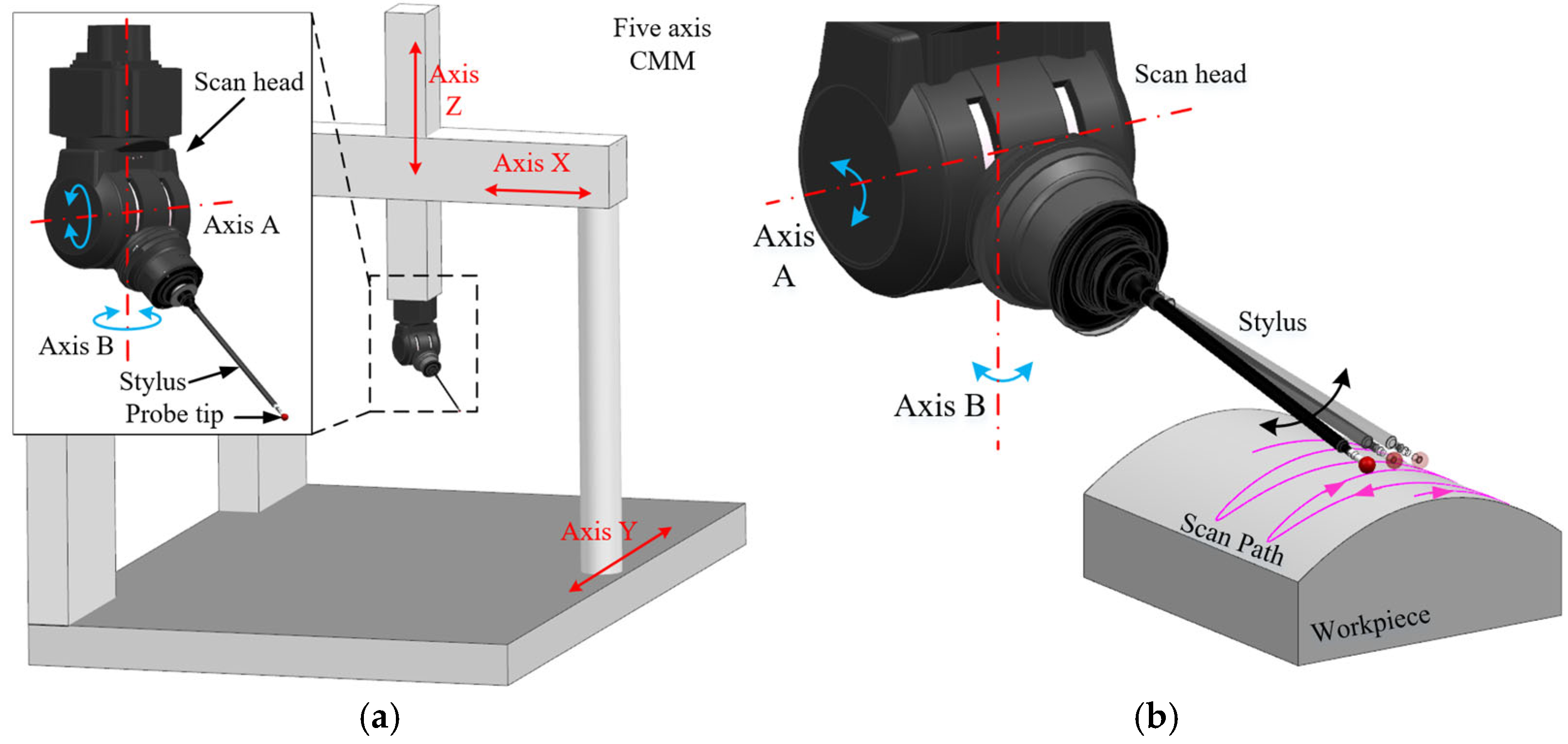




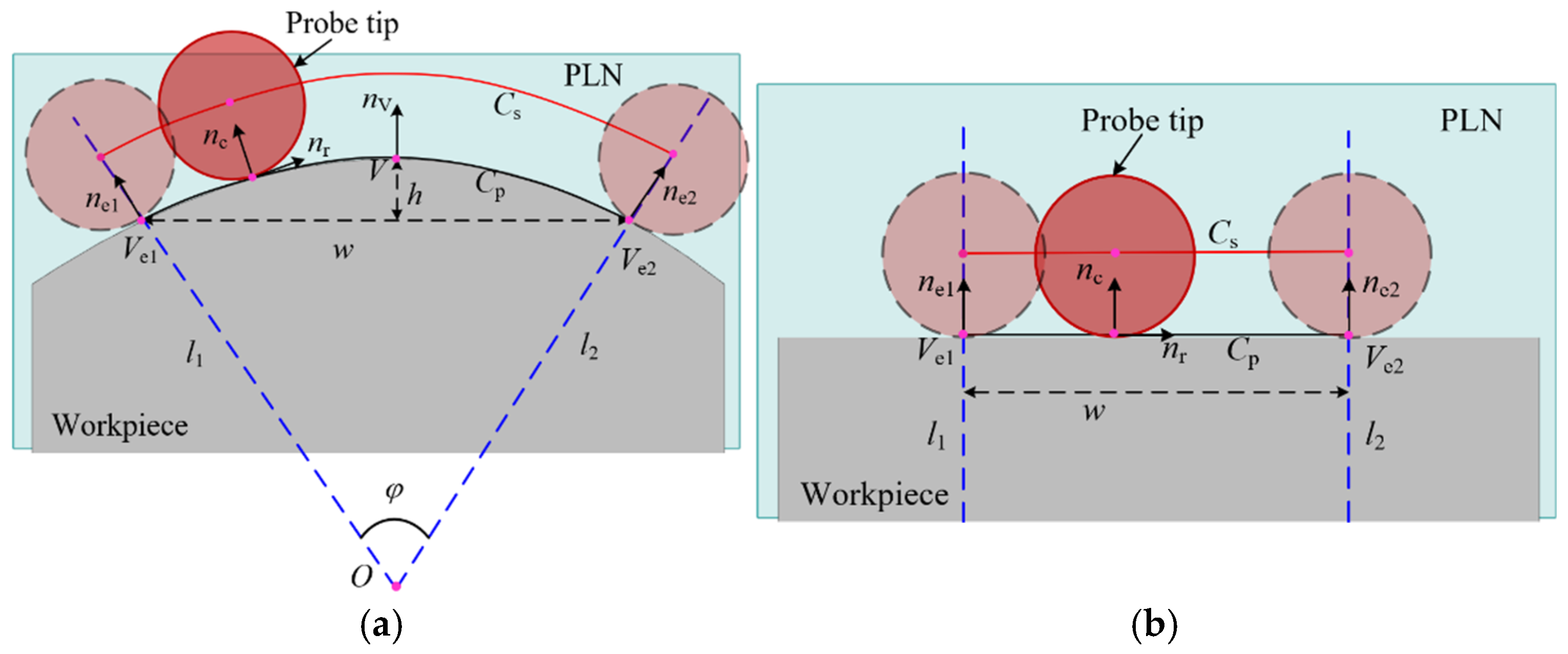

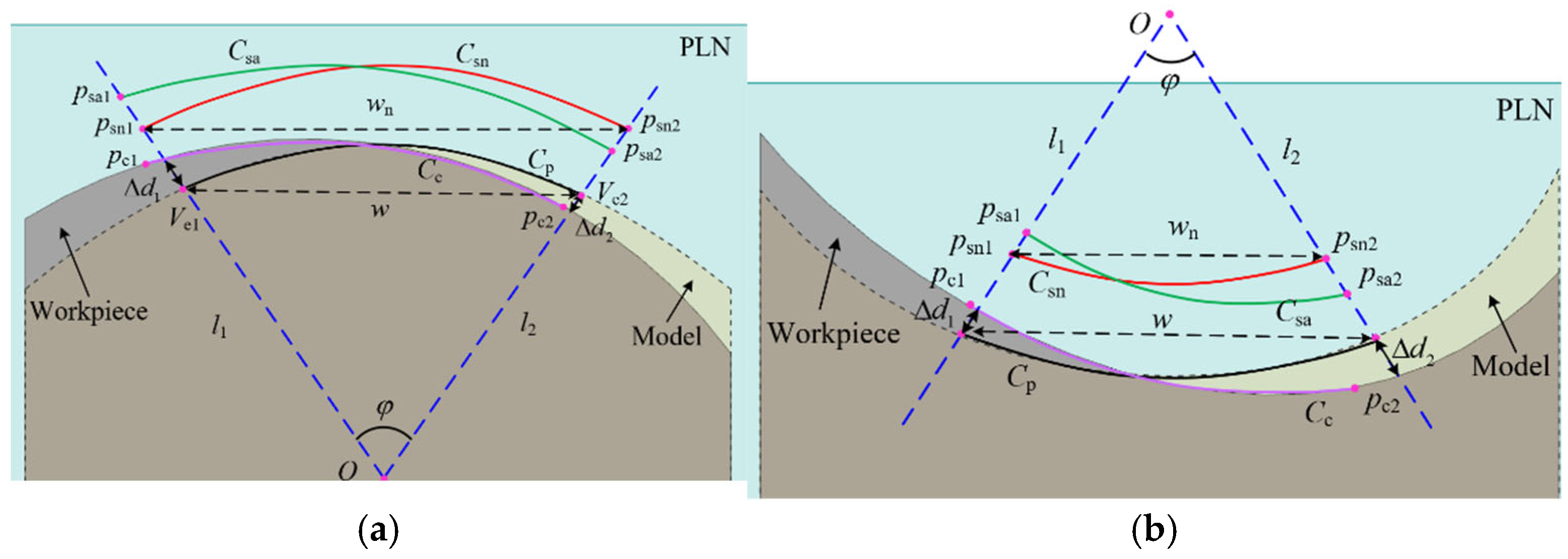
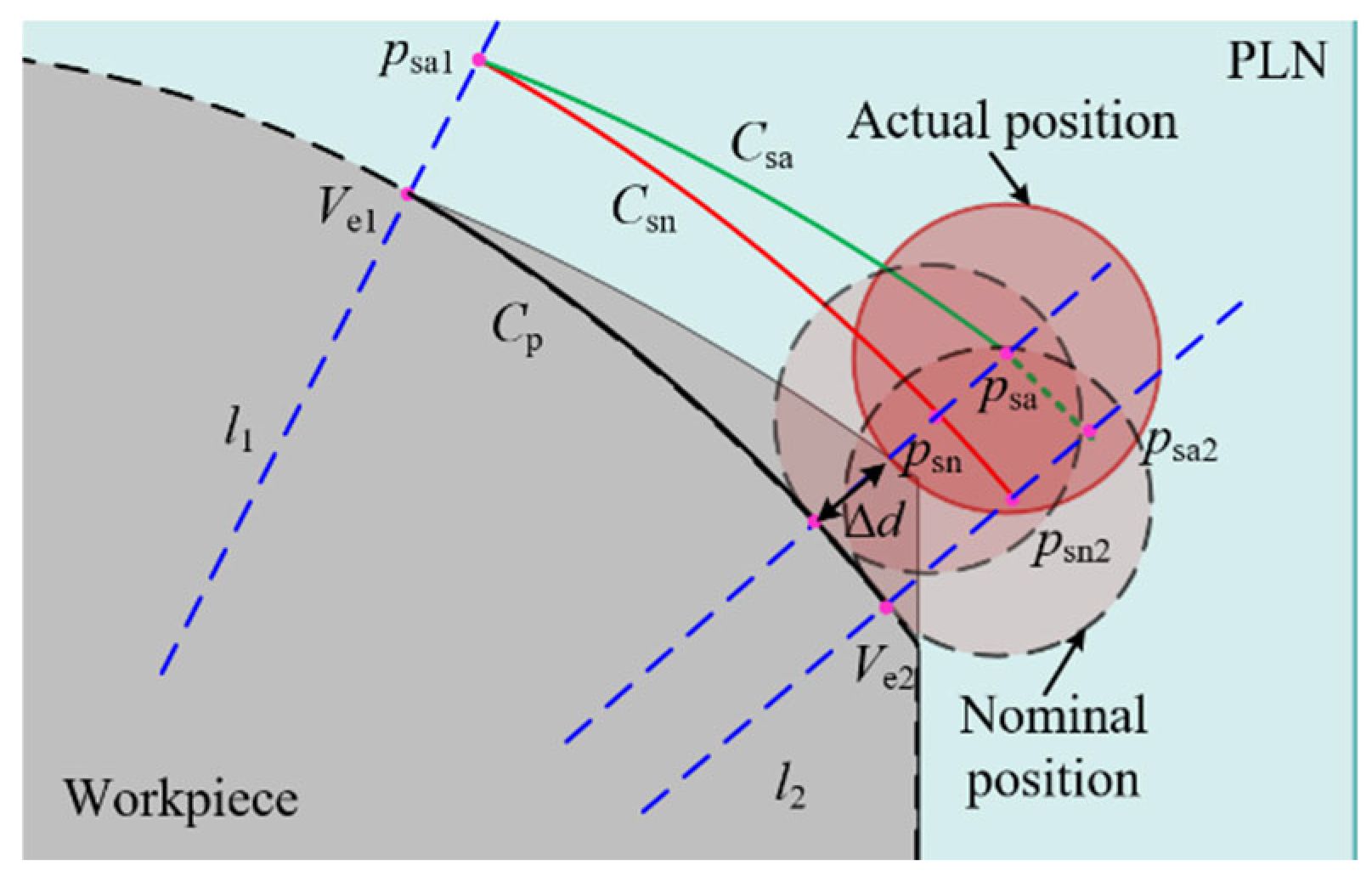

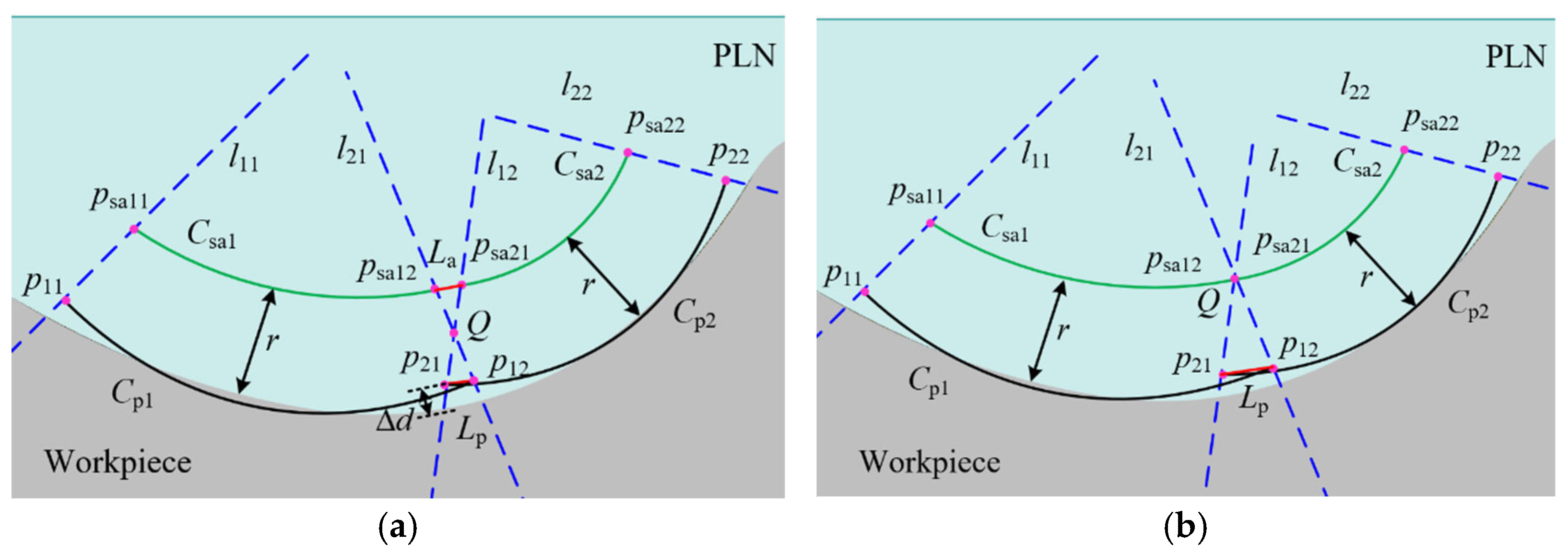
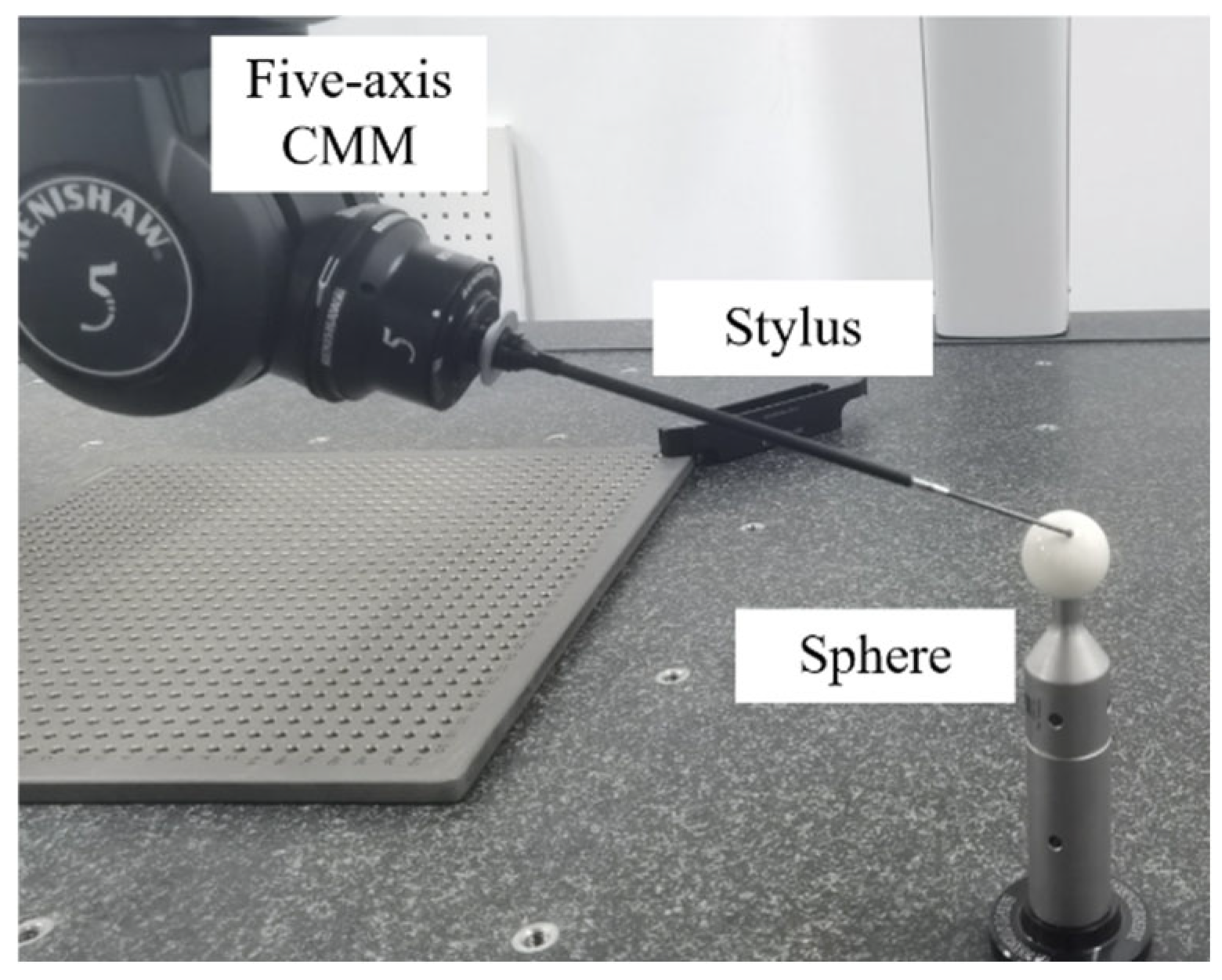
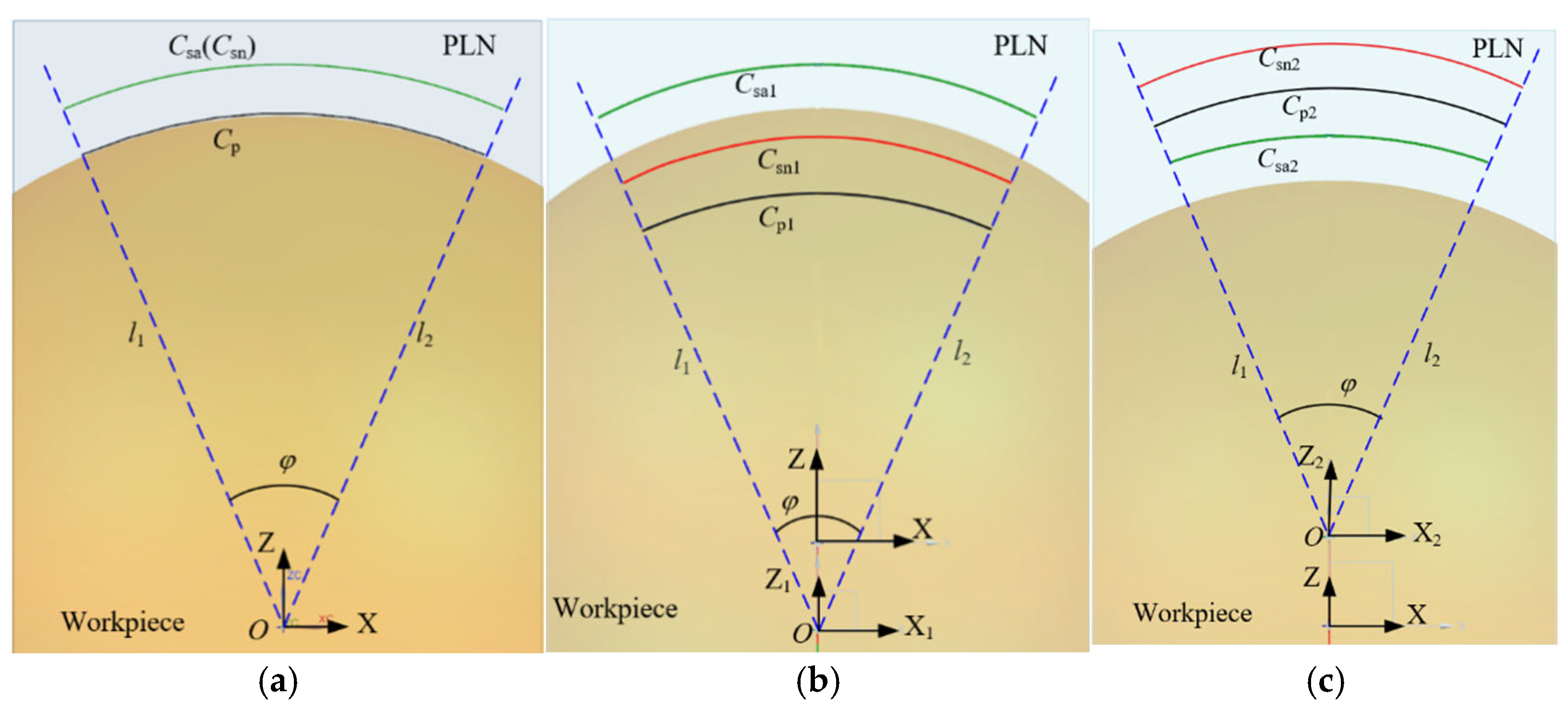
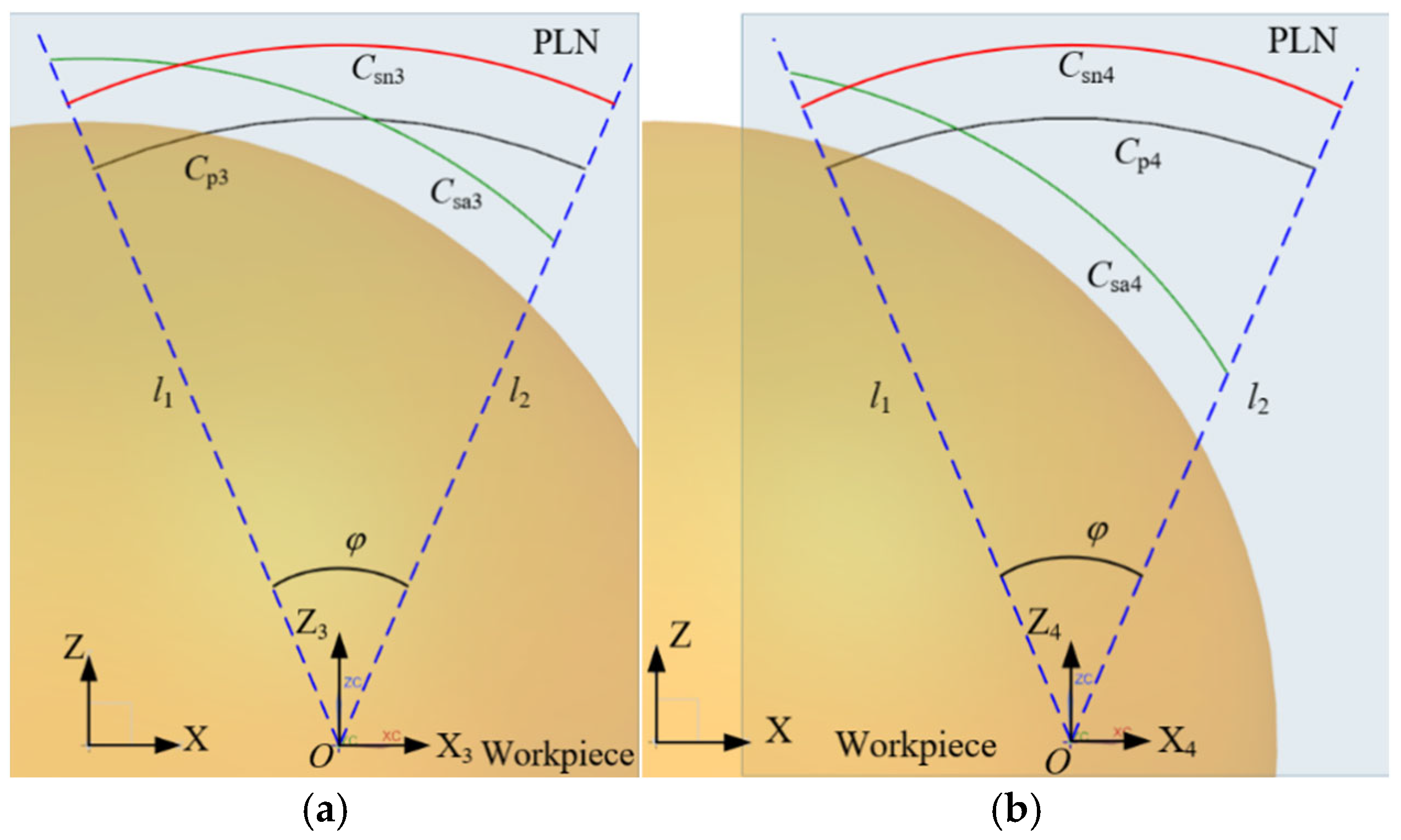
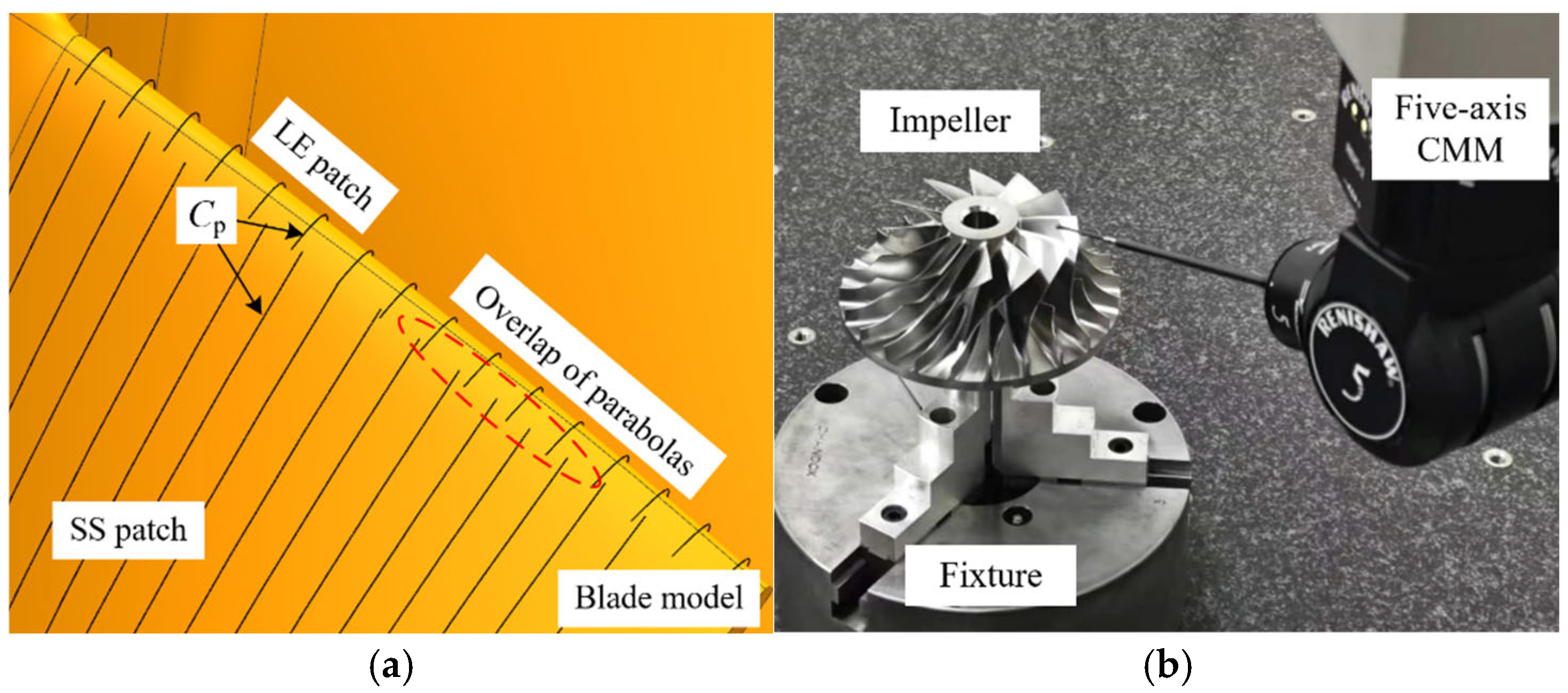

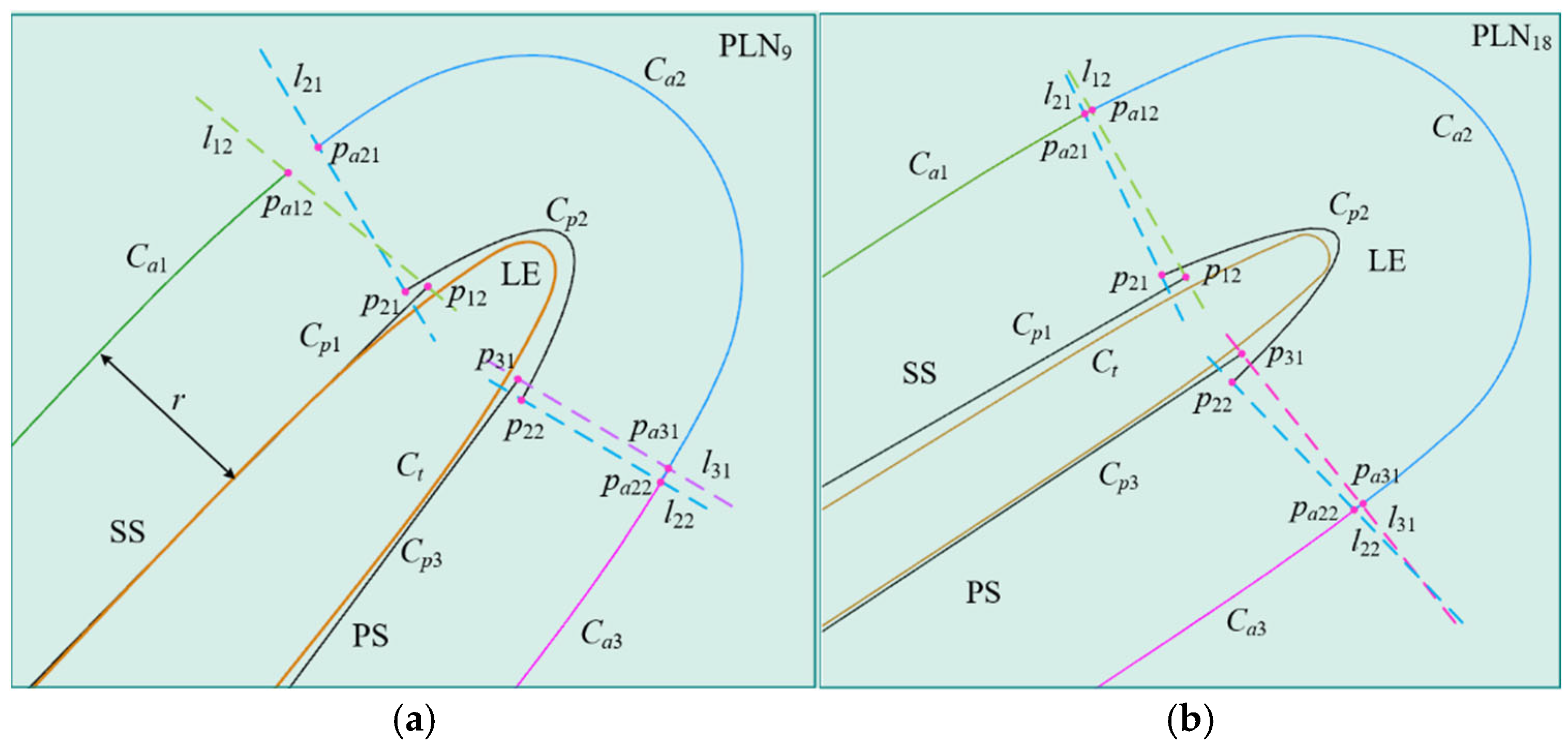
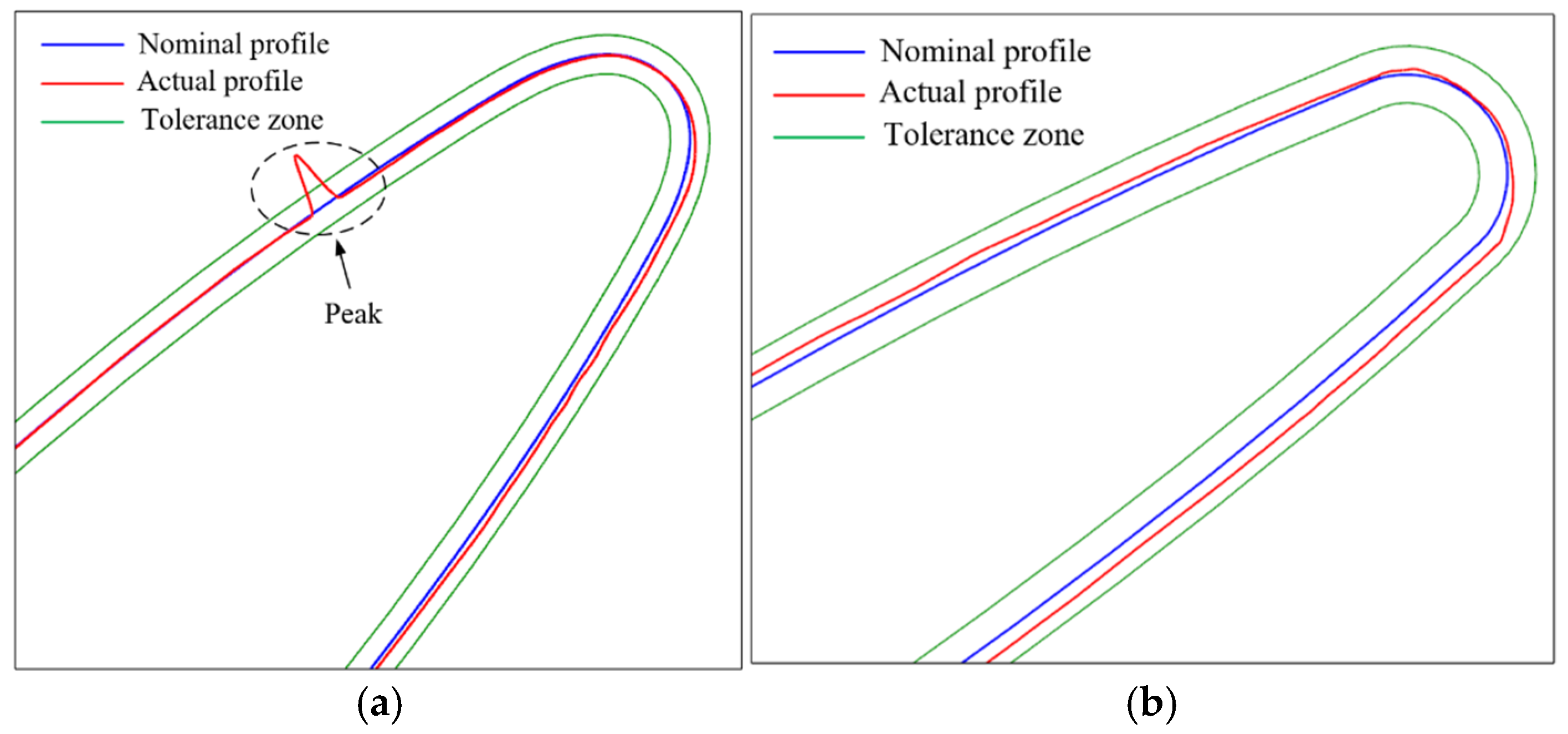
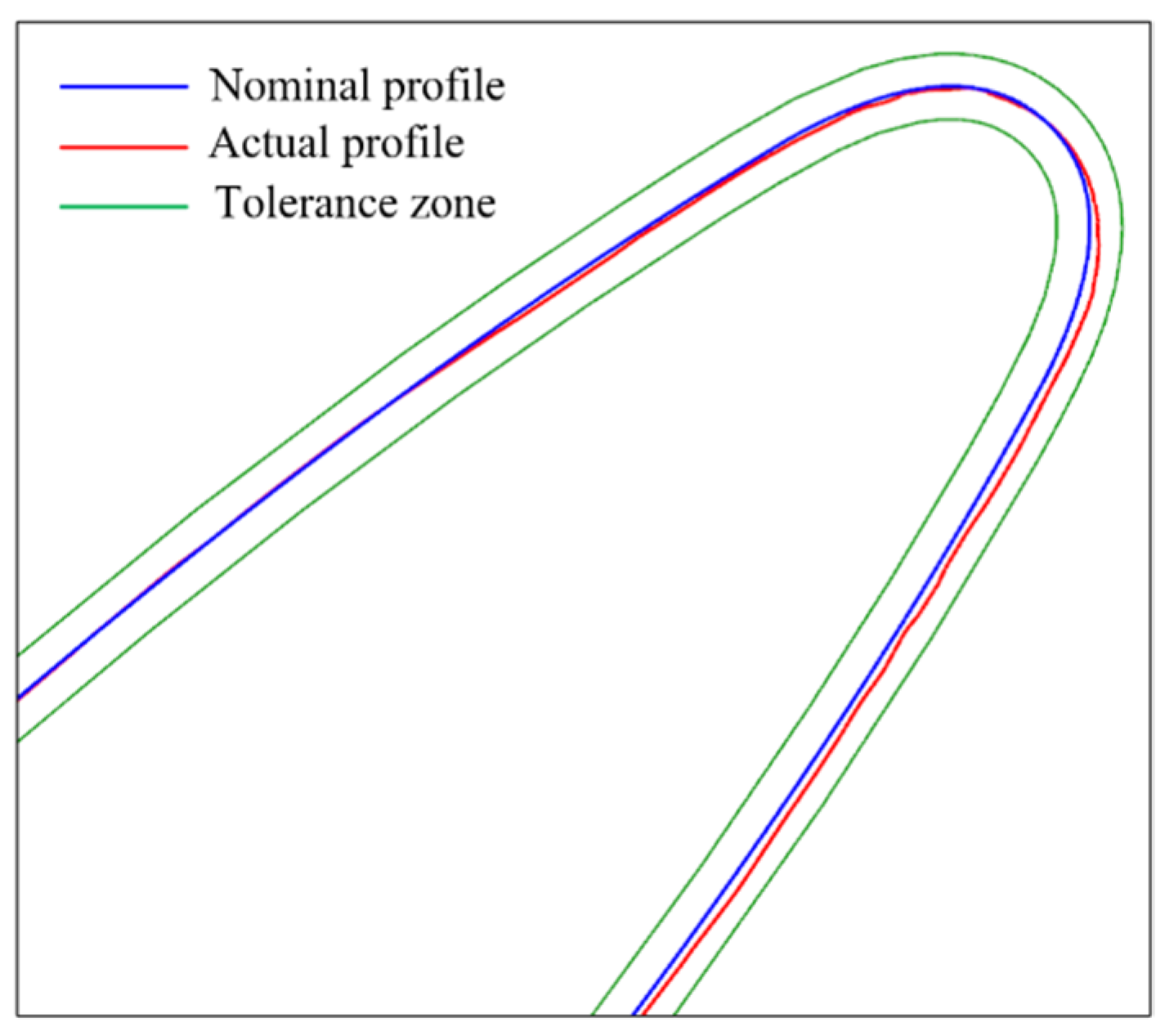
| Endpoint of Parabola | Normal Vector of Endpoint | Overlap Length of Sampling Points (La) | |||||
|---|---|---|---|---|---|---|---|
| p12 | p21 | n12 | n21 | Actual | Predicted | ||
| Test1 | PLN9 | (−2.01, −1.62) | (−2.43, −1.67) | (−0.72, 0.54) | (−0.36, 0.93) | non-overlap | non-overlap |
| PLN18 | (−3.48, −1.75) | (−3.89, −1.90) | (−0.54, 0.84) | (−0.38, 0.92) | 0.12 | 0.16 | |
| Test2 | PLN9 | (−1.86, −1.37) | (−2.66, −1.84) | (−0.76, 0.64) | (−0.41, 0.91) | 0.24 | 0.23 |
| PLN18 | (−3.22, −1.64) | (−3.94, −2.31) | (−0.55, 0.83) | (−0.39, 0.92) | 0.75 | 0.69 | |
Disclaimer/Publisher’s Note: The statements, opinions and data contained in all publications are solely those of the individual author(s) and contributor(s) and not of MDPI and/or the editor(s). MDPI and/or the editor(s) disclaim responsibility for any injury to people or property resulting from any ideas, methods, instructions or products referred to in the content. |
© 2025 by the authors. Licensee MDPI, Basel, Switzerland. This article is an open access article distributed under the terms and conditions of the Creative Commons Attribution (CC BY) license (https://creativecommons.org/licenses/by/4.0/).
Share and Cite
Chen, P.; Fang, T.; Chang, Z.; Xue, B.; Wan, N. Research on Boundary Displacement of Probe Trajectory Considering Deviations in Five-Axis Sweep Scanning Measurement. Micromachines 2025, 16, 759. https://doi.org/10.3390/mi16070759
Chen P, Fang T, Chang Z, Xue B, Wan N. Research on Boundary Displacement of Probe Trajectory Considering Deviations in Five-Axis Sweep Scanning Measurement. Micromachines. 2025; 16(7):759. https://doi.org/10.3390/mi16070759
Chicago/Turabian StyleChen, Peng, Tao Fang, Zhiyong Chang, Bowen Xue, and Neng Wan. 2025. "Research on Boundary Displacement of Probe Trajectory Considering Deviations in Five-Axis Sweep Scanning Measurement" Micromachines 16, no. 7: 759. https://doi.org/10.3390/mi16070759
APA StyleChen, P., Fang, T., Chang, Z., Xue, B., & Wan, N. (2025). Research on Boundary Displacement of Probe Trajectory Considering Deviations in Five-Axis Sweep Scanning Measurement. Micromachines, 16(7), 759. https://doi.org/10.3390/mi16070759






